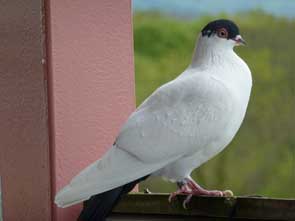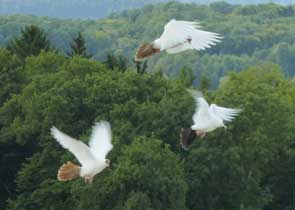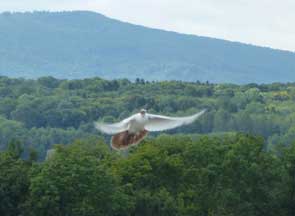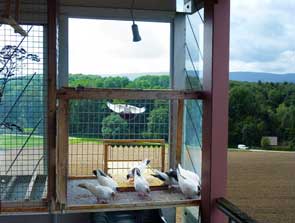Hamburg Helmets


Since 1996 I was a passionate Tippler-breeder. Unfortunately at the same time the population of the peregrine falcon recovered. The peregrine falcon is the biggest enemy of the pigeons. Every year the loss of pigeons due to the birds of prey increased. In 2012 the loss of my Tipplers due to the peregrine falcon reached its summit. I had six pairs of Tipplers and they were not able to equal the losses due to the birds of prey. They had destroyed the first brood before I could flight train the second. In the 17 years in which I had flown with Tipplers the peregrine falcons have killed more than 300 Tipplers in a most cruel way!! (see also www.flugtippler.chDisadvantages). The financial loss that was caused by the birds of prey adds up to about 15’000.-. Who will repay me this immense damage, maybe the bird protection groups? This is why with a heavy heart I decided to separate myself from my beloved Tipplers.
Tipple Substitution
While searching for a new Flying pigeon breed 4 criteria were important to me. 1. They shouldn’t fly too long and not have a quiet flight. 2. They shouldn’t fly above the lower flight height (These are all points that make it harder for the peregrine falcon to kill them). 3. They have to be quiet and trusting in the pigeonry. 4. They should also look stunning. After a long search I stumbled upon the Hamburg Helmets. This breed has fulfilled all these points and also held what it “promised”.
Hamburg Helmet or Plate Tumbler

Blue smooth-headed Hamburg Helmet/Plate tumbler
The Hamburg Helmets are of middle height; the legs are short and are ringed with 7mm rings. The beak is of average length. The color of the head is white, the head plate and the tail might be black, red, yellow, blue or light blue. They exist with or without a recursive crest.
 Blue Hamburg Helmet with recursive crest
Blue Hamburg Helmet with recursive crest
It is a trusting and graceful pigeon. It is very quiet in the pigeonry and also not aggressive towards fellow pigeons. If you try to catch them, they are very lively pigeons. For breeding they are very reliable parents, they are also often used as foster mothers. While cleaning the nest boxes they stay put on their eggs. I noticed that all pairs have a great need to bring nesting material into the nesting bowl during the breeding period. Most of the nesting material was brought into the nest during the brooding. When they got new nesting material the brooding pigeons also came to get it. Once the nesting bowls were full the nesting material was put into the cells. I gave them lots of shredded paper. They weren’t fit as nesting material but it was more an occupation for the pigeons.


Breeding cells Breeding pair with young
 The cell is filled with nesting material
The cell is filled with nesting material
Swarm flyer
The Hamburg Helmets are swarm flyers. The ideal size of a swarm consists of 10-14 pigeons. They fly in lower flight height, packed tightly together and constantly change the flight direction, so that they fly S loops. While doing this they don’t lose height. They fly very fast and are agile flyers (This flying technique makes it harder for birds of prey to catch them). From time to time the whole swarm lets itself fall (this is called tipping) to rise again to earlier height shortly thereafter. The flying time is 30-45 minutes. Apparently there are swarms that fly up to 2h, but this isn’t typical flying time for the Hamburg Helmet


The Hamburg Helmets during the flight.
If you want to make your Hamburg Helmets happy you have to give them a bathing opportunity. They will turn into real bathing addicts and can’t get enough of it. Often they go into the water several times, get out shortly to again diving into the water.
 They love to bath.
They love to bath.
They have a very good orientation sense. While training them to fly this is a huge advantage, also during an attack by a bird of prey, when they get driven from each other. The young Helmets also begin to strive around as one knows from the carrier pigeons.
As mentioned above they are swarm flyers, which means that they are practically glued together. If one of them lands everybody else also lands and they sit closely together. Several minutes after landing they come into the pigeonry without Droppers. As soon as one has landed on the landing board the others follow (I position the landing board once they have landed on the roof). This is a very pleasant trait of the Helmets.

The Helmets have landed and wait until the landing board is put out so they can go into the pigeonry.


The Helmets are in the pigeonry
Scoring
The scores fort he (HH Flugkalotten), established by the „Hamburger – Eimsbütteler RTZV v. 1888 and DHC – Gruppe Hamburg Stade“.
Fliing time: 1 point per minute.
Tilting : 3 x 10 Pkt.
Tipping : Per tipping by the whole flock 5 points each.
Entering: All pigeons in the pigeonry within 10min (after landing) = 20 points.
They are no subtractions when losing pigeons to birds of prey.
I find it very positive that one reacts to the bird of prey plague for scoring.
For the Hamburg Helmets it would be a big advantage if more flights would be taken in so that the desired flying technique is being cemented in the breed. Unfortunately this is not the case at the moment. One of the requirements is that the same scoring is taken over by all Flight pigeon clubs. Otherwise the Hamburg Helmets will continue to not fly a clear flying technique.
They are also called Plate Tumblers. 300 years ago they were called “Calotts” in France, that’s how the priest caps are called there. The origin is assumed to be in old Persia where a lot of flight pigeon races come from. Next to the different Helmets the Hamburg Helmet is supposed to be a culture breed for hundreds of years. They were mainly flown in Hamburg from pigeonries on rooftops
Source: E +I. Jungnickel 2013
 A pair of Hamburg Helmets
A pair of Hamburg Helmets
Walter Stettler CH Binningen www.flugtippler.ch